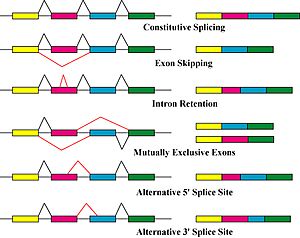Isoform facts for kids
A protein isoform is like having different versions of the same tool, but for your body! Imagine a Swiss Army knife. It's one tool, but it can be a knife, a screwdriver, or a can opener. In the same way, a protein isoform is a slightly different form of a protein that can do similar or sometimes even different jobs in your body.
These different protein versions can be made in a few ways. Sometimes, they come from genes that are very similar to each other. Other times, they are all made from the *exact same gene* through a clever process called alternative splicing. Also, tiny changes in your DNA called SNPs (pronounced "snips") can lead to many different protein isoforms. SNPs are like small spelling differences in the DNA code, found at specific spots in a gene.
Contents
What Are Proteins?
Proteins are super important molecules in your body. Think of them as tiny workers that do almost everything! They build your muscles, help you digest food, fight off sickness, and even carry oxygen in your blood. Each protein has a specific shape, and this shape helps it do its job.
What Are Protein Isoforms?
Sometimes, your body needs slightly different versions of the same protein. These different versions are called protein isoforms. They are like different models of a car – they are all cars, but one might be a sedan, another an SUV, and another a sports car. They all get you from A to B, but they do it in slightly different ways or have different features.
For example, a protein might be needed in your brain and also in your heart. The basic job might be similar, but a slightly different version (an isoform) might work better in the brain, while another works better in the heart.
How Do Cells Make Different Protein Versions?
Cells are very smart and have several ways to create these different protein isoforms.
Alternative Splicing: One Gene, Many Proteins
One of the main ways cells make different protein isoforms from a single gene is through something called alternative splicing. Imagine a gene as a long recipe book for a protein. This recipe book has many chapters (called exons) and some blank pages between them (called introns). When your cell reads this recipe, it first makes a full copy, including the blank pages.
Then, during splicing, the cell acts like a clever editor. It cuts out the blank pages (introns) and sometimes even skips or includes different chapters (exons).
- For one protein, it might use chapters 1, 2, and 3.
- For another isoform of the same protein, it might use chapters 1, 3, and 4.
By choosing which parts of the gene to include, the cell can create several different protein isoforms from just one original gene. This is a very efficient way for your body to get a lot of variety from a limited number of genes.
Tiny DNA Changes: SNPs
Another common reason for protein isoforms is tiny differences in your DNA called Single Nucleotide Polymorphisms (SNPs). A nucleotide is one of the basic building blocks of DNA. Think of your DNA as a long string of letters (A, T, C, G). An SNP is when just one of these letters is different at a specific spot in the DNA.
For example, if one person has an 'A' at a certain spot in a gene, another person might have a 'G' at that exact same spot. This small change in the DNA code can sometimes lead to a slightly different protein being made. These different proteins are also considered isoforms. SNPs are very common and contribute to the unique differences between people.
Why Are Protein Isoforms Important?
Protein isoforms are crucial for the complexity and flexibility of living things. They allow a single gene to produce many different proteins, each with a slightly different function or location in the body. This means our bodies can do a lot of different jobs with fewer genes. They help our bodies adapt to different situations and ensure that specific tissues or organs have the exact proteins they need to function correctly.
Images for kids
-
Protein A, B and C are isoforms encoded from the same gene through alternative splicing.
See also
 In Spanish: Isoforma para niños
In Spanish: Isoforma para niños



